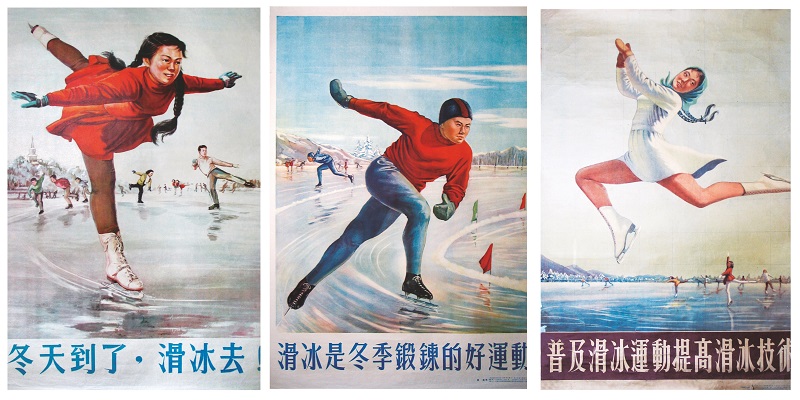Skating Fever in the Early Days of New China

Back in the 1950s, skating was easily the hottest winter sport in Beijing.
When the Beijing Municipal Working Committee of the Chinese New Democracy Youth League organized its New Year celebration on January 2, 1950, ice sports at Beihai Park was a central activity. The eclectic list of events included speed skating, color flag relay, and the highly popular “dragon parade.” In a dragon parade, dozens of people link hands while snaking around the ice rink to create a spectacular scene.
Back then, there were a lot of public ice rinks including those in Beihai Park, Shichahai Lake, Taoranting Park, and the Summer Palace. Institutions with ponds, especially schools, would draw on natural conditions to build ice rinks, while those without such endowment would enclose a vacant lot where they could bring water to build makeshift ice rinks.
Skating enthusiasts included not only children and students, but also adults. However, skates were a luxury. Except for a few who could afford them, most would rent a pair or use homemade skates. Walking around toting a pair of skates over one’s shoulder would definitely draw envious eyes.
Of the many older Beijingers I have interviewed, most can recall skating in their youth. “First love is like fine wine served cup after cup,” wrote Wang Meng in his memoir Recollections of the Past. “With it, everything else becomes so intoxicating.”

Apparently, the Shichahai ice rink was one of those cups of fine wine for him. “In the winter of 1952, I spent virtually every Saturday night skating at Shichahai,” he wrote. “The ice rink was poorly furnished, but just to my taste: First, tasty chilled hawthorn juice was offered there. The warm reddish color was nothing short of a miracle in the cold winter. Second, the service staff would sharpen your skates for free, and the sparkling electric sharpener seemed so fascinating. Third was the most important reason: Soviet songs boomed on the loudspeakers. The most touching was ‘Who Knows Him’ performed by the Pyatnitsky Choir. The innocent, richly blazing tone of the folk song rendered by Russian harmonies invariably moved me to tears.”
Winter skating was popular for many reasons. First, the fresh feeling after the founding of the People’s Republic of China in 1949 made the people happy and carefree. Second, vigorous promotion was made by the Communist Youth League, the National Sports Commission, and other agencies. Third was influence from the Soviet Union. Skating was already quite popular in the Soviet Union, where many of the world’s best skaters lived.
In January 1954, the People’s Sports Publishing House was established. The same year, this state-level sports publishing institution published posters to promote skating, including Embracing Winter on Skates and Skating as a Good Winter Exercise.

People would skate for fun as well as joining amateur ice games occasionally featuring professional athletes organized by the Beijing Municipal Sports Commission or other agencies.
After the ice gala of 1950, ice sports games started to be organized in Beijing from 1951. In 1953, the first National Ice Games in Harbin became the first comprehensive national ice sports event after the founding of the People’s Republic of China.
The results, however, were not very encouraging due to the country’s poor foundation for ice sports. The National Sports Commission then proposed combining promotional campaigns and skill training to improve Chinese competitive capabilities in ice sports. The poster Popularizing Skating and Honing the Skills was published in such circumstances.
Alongside posters, publishing houses such as China Youth Press and the People’s Sports Publishing House also printed many books on ice sports to offer technical support for training and instruction.
At that time, the publicity campaigns were accompanied by ice games and activities seeking public participation and professional athlete demonstrations every winter in Beijing. Occasionally, Soviet ice-sport professionals were invited to engage in exchange events. Those activities contributed to the promotion and popularization of ice skating in Beijing and helped transform the capital city into a “bustling hive” in winter.
The author is the licensing division chief of the marketing department of Beijing Organising Committee for the 2022 Olympic and Paralympic Winter Games. He is also a sports memorabilia collector.